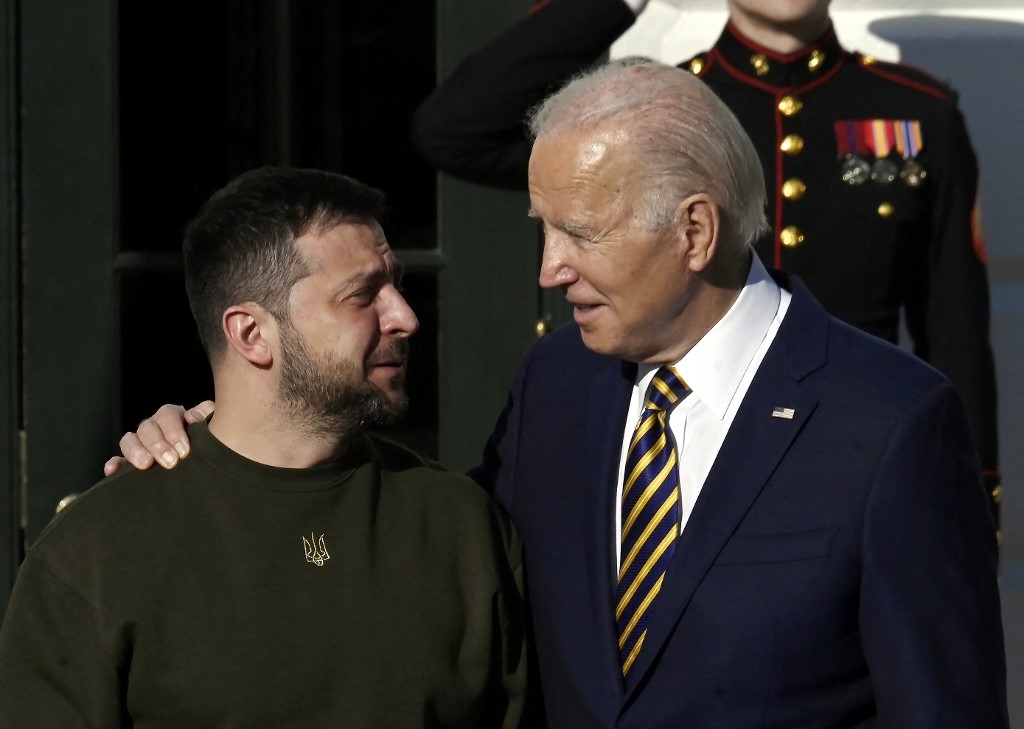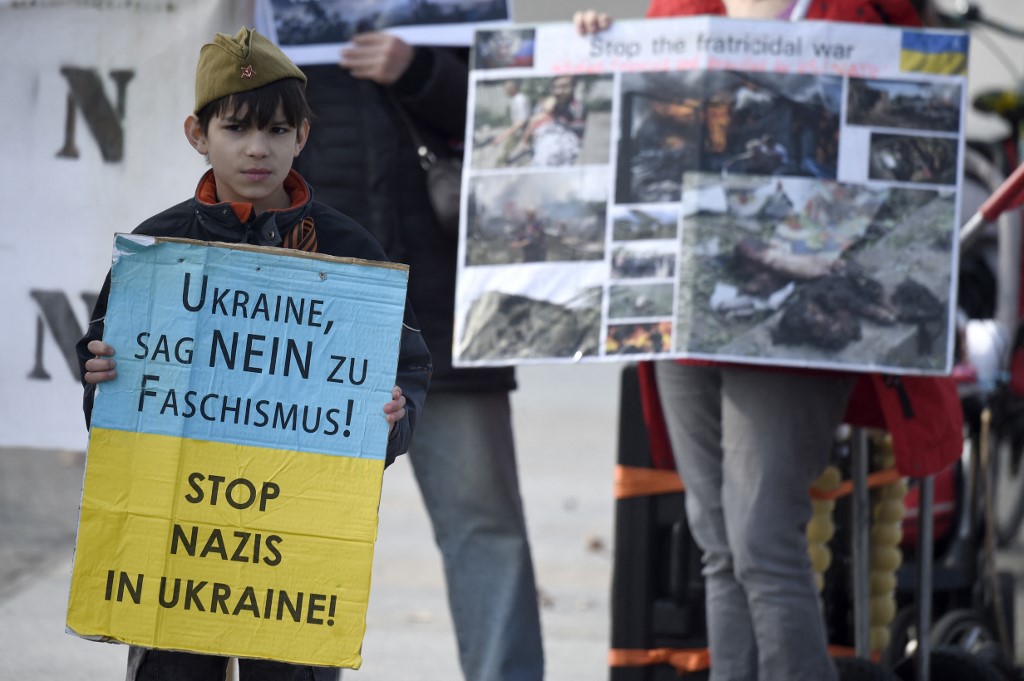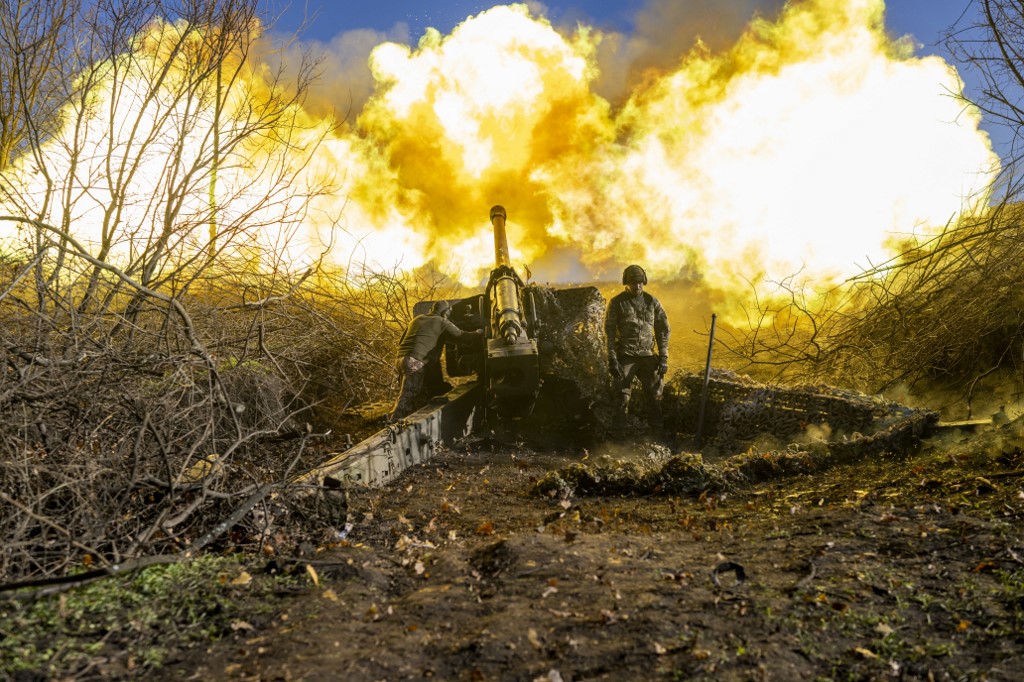Russia-Ukraine war: How the US paved the way to Moscow's invasion

Hindsight is a particularly powerful tool for analysing the Ukraine war, nearly a year after Russia’s invasion.
Last February, it sounded at least superficially plausible to characterise Russian President Vladimir Putin’s decision to send troops and tanks into his neighbour as nothing less than an “unprovoked act of aggression”.
Putin was either a madman or a megalomaniac, trying to revive the imperial, expansionist agenda of the Soviet Union. Were his invasion to go unchallenged, he would pose a threat to the rest of Europe.
Putin is Hitler, the time is 1938, and anyone seeking to turn down the heat is no different from Britain’s appeasing prime minister, Neville Chamberlain. Or so we have been told
Plucky, democratic Ukraine needed the West’s unreserved support - and a near-limitless supply of weapons - to hold the line against a rogue dictator.
But that narrative looks increasingly threadbare, at least if one reads beyond the establishment media - a media that has never sounded quite so monotone, so determined to beat the drum of war, so amnesiac and so irresponsible.
Stay informed with MEE's newsletters
Sign up to get the latest alerts, insights and analysis, starting with Turkey Unpacked
Anyone demurring from the past 11 months of relentless efforts to escalate the conflict - resulting in untold deaths and suffering, causing energy prices to skyrocket, leading to global food shortages, and ultimately risking a nuclear exchange - is viewed as betraying Ukraine, and dismissed as an apologist for Putin.
No dissent is tolerated.
Putin is Hitler, the time is 1938, and anyone seeking to turn down the heat is no different from Britain’s appeasing prime minister, Neville Chamberlain.
Or so we have been told. But context is everything.
End to 'forever wars'
Barely six months before Putin invaded Ukraine, President Joe Biden pulled the US military out of Afghanistan after a two-decade occupation. It was the apparent fulfilment of a pledge to end Washington’s “forever wars” that, he warned, “have cost us untold blood and treasure”.
The implicit promise was that the Biden administration was going not only to bring home US troops from the Middle East “quagmires” of Afghanistan and Iraq, but also to make sure US taxes stopped flooding abroad to line the pockets of military contractors, arms makers and corrupt foreign officials. US dollars would be spent at home, on solving homegrown problems.
But since Russia’s invasion, that assumption has unravelled. Ten months on, it looks fanciful that it was ever considered Biden’s intention.
Last month, the US Congress approved a mammoth top-up of largely military "support" for Ukraine, bringing the official total to some $100bn in less than a year, with doubtless much more of the costs hidden from public view. That is far in excess of Russia’s total annual military budget of £65bn.
Washington and Europe have been pouring weapons, including ever more offensive ones, into Ukraine. Emboldened, Kyiv has been shifting the field of battle ever deeper into Russian territory.
US officials, like their Ukrainian counterparts, speak of the fight against Russia continuing until Moscow is "defeated" or Putin toppled, turning this into another "forever war" of the very kind Biden had just forsworn - this one in Europe rather than the Middle East.
At the weekend, in the Washington Post, Condoleezza Rice and Robert Gates, two former US secretaries of state, called on Biden to "urgently provide Ukraine with a dramatic increase in military supplies and capability… It is better to stop [Putin] now, before more is demanded of the United States and NATO."
Last month, the head of Nato, Jens Stoltenberg, warned that a direct war between the western military alliance and Russia was a "real possibility".
Days later, Ukraine’s president, Volodymyr Zelensky, was given a hero’s welcome during a "surprise" visit to Washington. The US Vice-President Kamala Harris and House Speaker Nancy Pelosi unfurled a large Ukrainian flag behind their guest, like two starstruck cheerleaders, as he addressed Congress.
US legislators greeted Zelensky with a three-minute standing ovation - even longer than that awarded to that other well-known “man of peace” and defender of democracy, Israel’s Benjamin Netanyahu. The Ukrainian president echoed the US wartime president, Franklin D Roosevelt, in calling for “absolute victory”.
All of this only underscored the fact that Biden has rapidly appropriated the Ukraine war, exploiting Russia’s “unprovoked” invasion to wage a US proxy war. Ukraine has supplied the battlefield on which Washington can revisit the unfinished business of the Cold War.
Given the timing, a cynic might wonder whether Biden pulled out of Afghanistan not to finally focus on fixing the US, but to prepare for a new arena of confrontation, to breathe new life into the same old US script of full-spectrum military dominance.
Did Afghanistan need to be “abandoned” so that Washington’s treasure could be invested in a war on Russia instead, but without the US body bags?
Hostile intent
The rejoinder, of course, is that Biden and his officials could not have known Putin was about to invade Ukraine. It was the Russian leader’s decision, not Washington’s. Except…
Senior US policymakers and experts on US-Russia relations - from George Kennan and William Burns, currently Biden’s CIA director, to John Mearsheimer and the late Stephen Cohen - had been warning for years that the US-led expansion of Nato onto Russia’s doorstep was bound to provoke a Russian military response.
Putin had warned of the dangerous consequences back in 2008, when Nato first proposed that Ukraine and Georgia - two former Soviet states on Russia’s border - were in line for membership. He left no room for doubt by almost immediately invading, if briefly, Georgia.
It was that very "unprovoked" reaction that presumably delayed Nato carrying through its plan. Nonetheless, in June 2021, the alliance reaffirmed its intention to award Ukraine Nato membership. Weeks later, the US signed separate pacts on defence and strategic partnership with Kyiv, effectively giving Ukraine many of the benefits of belonging to Nato without officially declaring it a member.
Between the two Nato declarations, in 2008 and 2021, the US repeatedly signalled its hostile intent to Moscow, and how Ukraine might assist its aggressive, geostrategic posturing in the region.
Between 2008 and 2021, the US repeatedly signalled its hostile intent to Moscow, and how Ukraine might assist its aggressive posturing in the region
Back in 2001, shortly after Nato began expanding towards Russia’s borders, the US unilaterally withdrew from the 1972 Anti-Ballistic Missile (ABM) Treaty, intended to avoid an arms race between the two historic enemies.
Unencumbered by the treaty, the US then built ABM sites in Nato’s expanded zone, in Romania in 2016 and Poland in 2022. The cover story was that these were purely defensive, to intercept any missiles fired from Iran.
But Moscow could not ignore the fact that these weapons systems were capable of operating offensively too, and that nuclear-tipped Cruise missiles could for the first time be launched at short notice towards Russia.
Compounding Moscow’s concerns, in 2019 President Donald Trump unilaterally withdrew from the 1987 Treaty on Intermediate-Range Nuclear Forces. That opened the door to the US launching a potential first strike on Russia, using missiles stationed in newly admitted Nato members.
As Nato flirted once again with Ukraine in the summer of 2021, the danger of the US being able, with Kyiv’s help, to launch a preemptive strike - destroying Moscow’s ability to retaliate effectively, and upending its nuclear deterrent - must have weighed heavily on Russian policymakers’ minds.
US fingerprints
It did not end there. Post-Soviet Ukraine was deeply divided geographically and electorally over whether it should look to Russia or to Nato and the European Union for its security and trade. Close-run elections swung between these two poles. Ukraine was a country mired in permanent political crisis, as well as profound corruption.
That was the context for a coup/revolution in 2014 that overthrew a government in Kyiv elected to preserve ties with Moscow. Installed in its place was one that was openly anti-Russian. Washington’s fingerprints - disguised as “democracy promotion” - were all over the sudden change of government to one tightly aligned with US geostrategic goals in the region.
Many Russian-speaking communities in Ukraine - concentrated in the east, south and the Crimea peninsula - were incensed by this takeover. Worried that the new hostile government in Kyiv would try to sever its historic control of Crimea and Russia’s only warm-water naval port, Moscow annexed the peninsula.
According to a subsequent referendum, the local population overwhelmingly backed the move. Western media widely reported the result as fraudulent, but later western polling suggested Crimeans believed it fairly represented their will.
But it was the eastern Donbas region that would serve as the touch-paper for Russia’s invasion last February. A civil war quickly erupted in 2014 that pitted Russian-speaking communities there against ultra-nationalist, anti-Russian fighters mostly from western Ukraine, including unabashed neo-Nazis. Many thousands died in the eight years of fighting.
While Germany and France brokered the so-called Minsk accords, with Russia’s help, to stop the slaughter in the Donbas by promising the region greater autonomy, Washington looked to be incentivising the bloodshed.
It poured money and arms into Ukraine. It gave Ukraine’s ultra-nationalist forces training, and worked to integrate the Ukrainian military into Nato through what it termed “interoperability”. In July 2021, as tensions heightened, the US held a joint naval exercise with Ukraine in the Black Sea, Operation Sea Breeze, that led to Russia firing warning shots at a British naval destroyer that entered Crimea’s territorial waters.
By winter 2021, as Russian Foreign Minister Sergey Lavrov noted, Moscow had “reached our boiling point”. Russian troops massed on Ukraine’s border in unprecedented numbers - in an unmistakable sign that Moscow’s patience was running out over Ukraine’s collusion with these US-engineered provocations.
President Zelensky, who had been elected on a promise to make peace in the Donbas but appeared to be unable to subdue the far-right elements within his own military, pushed in precisely the opposite direction.
Ultra-nationalist Ukrainian forces intensified the shelling of the Donbas in the weeks before the invasion. At the same time, Zelensky shuttered critical media outlets, and would soon be banning opposition political parties and requiring Ukrainian media to implement a “unified information policy”. As tensions mounted, the Ukrainian president threatened to develop nuclear weapons and seek a fast-track Nato membership that would further mire the West in the slaughter in the Donbas and risk engagement with Russia directly.
Turning off the lights
It was then, after 14 years of US meddling on Russia’s borders, that Moscow sent in its soldiers - “unprovoked”.
Putin’s initial goal, whatever the western media narrative said, appeared to be as light a touch as possible given Russia was launching an illegal invasion. From the outset, Russia could have carried out its current, devastating attacks on Ukrainian civilian infrastructure, closing transport links and turning the lights off in much of the country. But it appeared to consciously avoid a US-style shock-and-awe campaign.
Instead it initially concentrated on a show of force. Moscow mistakenly seems to have assumed Zelensky would accept Kyiv had overplayed its hand, realise that the US - thousands of miles away - could not serve as a guarantor of its security, and be pressured into disarming the ultra-nationalists who had been targeting Russian communities in the east for eight years.
That is not how things played out. Seen from Moscow’s perspective, Putin’s error looks less like he launched an unprovoked war against Ukraine than that he delayed too long in invading. Ukraine’s military “interoperability” with Nato was far more advanced than Russian planners seem to have appreciated.
In a recent interview, former German Chancellor Angela Merkel, who oversaw the Minsk negotiations to end the Donbas slaughter, appeared - if inadvertently - to echo this view: the talks had provided cover while Nato readied Ukraine for a war against Russia.
Washington cares less about Ukraine’s future than it does about depleting Russia’s military strength and isolating it from China
Rather than a quick victory and an agreement on new regional security arrangements, Russia is now engaged in a protracted proxy war against the US and Nato, with Ukrainians serving as cannon fodder. The fighting, and killing, could continue indefinitely.
With the West resolved against peacemaking, and shipping in armaments as fast as they can be made, the outcome looks bleak: either a further grinding, bloody territorial division of Ukraine into pro-Russia and anti-Russia blocs through force of arms, or escalation to a nuclear confrontation.
Without prolonged US intervention, the reality is that Ukraine would have had to come to an accommodation many years ago with its much larger, stronger neighbour - just as Mexico and Canada have had to do with the US. Invasion would have been avoided. Now Ukraine’s fate is largely out of its hands. It has become another pawn on the chessboard of superpower intrigues.
Washington cares less about Ukraine’s future than it does about depleting Russia’s military strength and isolating it from China, apparently the next target in US sights as it seeks to achieve full-spectrum dominance.
At the same, Washington has scored a wider goal, smashing apart any hope of a security accommodation between Europe and Russia; deepening European dependency on the US, both militarily and economically; and driving Europe into colluding with its new “forever wars” against Russia and China.
Much more treasure will be spent, and more blood spilled. There will be no winners apart from the neoconservative foreign policy hawks who dominate Washington and the war industry lobbyists who profit from the West’s endless military adventures.
The views expressed in this article belong to the author and do not necessarily reflect the editorial policy of Middle East Eye.
This article is available in French on Middle East Eye French edition.
Middle East Eye delivers independent and unrivalled coverage and analysis of the Middle East, North Africa and beyond. To learn more about republishing this content and the associated fees, please fill out this form. More about MEE can be found here.









